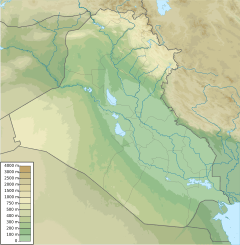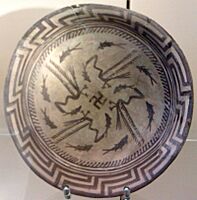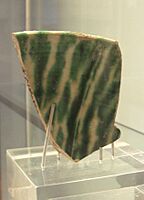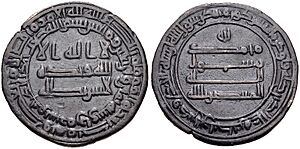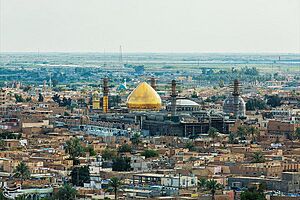Samarra facts for kids
Quick facts for kids
Samarra
سَامَرَّاء
|
|
|---|---|
|
City
|
|
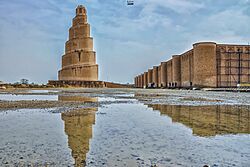
The spiral minaret of the Great Mosque of Samarra (2016)
|
|
| Country | |
| Governorate | Saladin Governorate |
| Population
(2003 est)
|
|
| • Total | 348,700 |
| UNESCO World Heritage Site | |
| Official name | Samarra Archaeological City |
| Criteria | Cultural: ii, iii, iv |
| Inscription | 2007 (31st Session) |
| Endangered | 2007- |
| Area | 15,058 ha |
| Buffer zone | 31,414 ha |
Samarra (Arabic: سَامَرَّاء, Sāmarrāʾ) is an important city in Iraq. It is located on the east bank of the Tigris River in the Saladin Governorate. The city is about 125 kilometers (78 mi) north of Baghdad.
The modern city of Samarra was started in 836 CE. It was built by the Abbasid caliph al-Mu'tasim. He wanted a new capital city and a military base. In 2003, about 348,700 people lived there.
The ancient ruins of Samarra still show much of the old city's design. They also have many historical buildings and art. In 2007, UNESCO named it a World Heritage Site. This means it is a very important place for everyone to protect.
Contents
History of Samarra
Ancient Times in Samarra
The very first remains of ancient Samarra were found between 1911 and 1914. A German archaeologist named Ernst Herzfeld led these digs. Samarra became known for the Samarra culture, a very old civilization.
This culture was one of the first "town states" in the Near East. It thrived from about 5,500 BCE and ended around 3,900 BCE. Old notes and photos from these digs are now kept in Washington, D.C.
Samarra in Later Eras
A city called Sur-marrati might have been located near modern Samarra. It was rebuilt by Sennacherib around 690 BC. Ancient writers also mentioned places like Greek Souma and Latin Sumere. These names might refer to Samarra.
A large canal, the Qatul al-Kisrawi, brought water from the Tigris River. It was built by Khosrau I (531–578). To celebrate this, a tower was built south of Samarra. A palace with a large hunting park was also created. Later, Caliph Harun al-Rashid started building a new city. It was shaped like an octagon but was never finished.
Samarra as the Abbasid Capital
In 836 CE, the Abbasid Caliph Al-Mu'tasim made Samarra his new capital. He built huge palaces and homes for his guards. These guards came from places like Central Asia and Iran. They were important soldiers, even though some were called "slave soldiers."
The city grew even more under Caliph al-Mutawakkil. He built grand palaces, like al-Mutawakkiliyya. He also built the famous Great Mosque of Samarra in 847. This mosque has a unique spiral minaret called the Malwiya. He also built the large Bulkuwara palace for his son.

The leader of the Church of the East, Sargis, even moved his main office to Samarra. This was to be close to the caliph's power.
Samarra was the caliph's home until 892. Then, al-Mu'tadid moved the capital back to Baghdad. The city of Samarra then became less important. Its population likely went down, but it remained a market town.
Later, Samarra became a major place for religious visits. In the 12th and 13th centuries, the Tigris River changed its path. This moved the main road between Baghdad and Mosul. Samarra then lost its importance as a trading city.
Modern Samarra
In the 1700s, a big battle happened near Samarra. It was part of the Ottoman–Persian War. Over 50,000 soldiers from both sides were hurt or killed. This battle helped decide that Ottoman Iraq would stay under Istanbul's rule.
In the 1950s, Samarra became important again. A dam called the Samarra Barrage was built. This created a permanent lake, Lake Tharthar. The dam helped stop floods in Baghdad. Many people had to move because of the dam, which made Samarra's population grow.
Samarra is a key city in the Saladin Governorate. It has important Shi'i holy sites, including the tombs of several Shi'i Imams. The city was traditionally home to mostly Sunni Arabs.
During the Iraq War, tensions grew between Sunnis and Shi'a. On February 22, 2006, the golden dome of the al-Askari Mosque was bombed. This led to many protests and attacks across Iraq. No group said they were responsible. In 2007, the mosque was attacked again. Its two minarets were destroyed. The clock tower was also blown up.
After the 2006 bombing, the mosque was closed. A curfew was put on the city. In 2009, the mosque reopened while it was being fixed. Violence has continued in Samarra with bombings in 2011 and 2013. In 2014, the city was attacked by the Islamic State of Iraq and the Levant (ISIL). ISIL forces took over some buildings but were pushed back by the Iraqi army. The Imam Dur Mausoleum, a historic tomb, was destroyed by ISIL in 2014.
Geography
Climate in Samarra
Samarra has a hot desert climate. This means it is very hot and dry. Most of the rain falls in the winter months. The average yearly temperature in Samarra is about 22.7 °C (72.9 °F). Around 171 mm (6.73 in) of rain falls each year.
| Climate data for Samarra | |||||||||||||
|---|---|---|---|---|---|---|---|---|---|---|---|---|---|
| Month | Jan | Feb | Mar | Apr | May | Jun | Jul | Aug | Sep | Oct | Nov | Dec | Year |
| Mean daily maximum °C (°F) | 15.3 (59.5) |
18.0 (64.4) |
22.1 (71.8) |
28.3 (82.9) |
35.7 (96.3) |
41.1 (106.0) |
43.9 (111.0) |
43.6 (110.5) |
39.7 (103.5) |
33.2 (91.8) |
24.4 (75.9) |
17.4 (63.3) |
30.2 (86.4) |
| Mean daily minimum °C (°F) | 4.4 (39.9) |
5.9 (42.6) |
9.3 (48.7) |
14.2 (57.6) |
19.6 (67.3) |
23.5 (74.3) |
25.9 (78.6) |
25.4 (77.7) |
21.4 (70.5) |
16.4 (61.5) |
10.6 (51.1) |
5.8 (42.4) |
15.2 (59.4) |
| Average precipitation mm (inches) | 25 (1.0) |
30 (1.2) |
29 (1.1) |
21 (0.8) |
8 (0.3) |
0 (0) |
0 (0) |
0 (0) |
0 (0) |
4 (0.2) |
20 (0.8) |
34 (1.3) |
127 (5.0) |
Religious Importance
Samarra is home to the al-Askari Shrine. This shrine holds the tombs of two very important Imams for Shias: Ali al-Hadi and Hasan al-Askari. They are the tenth and eleventh Shiʿi Imams.
It is also believed to be the place where Muhammad al-Mahdi, known as the "Hidden Imam," disappeared. This makes Samarra a very important place for Twelver Shias to visit. Also, Hakimah and Narjis, who were relatives of the Prophet Muhammad, are buried there. This makes the mosque one of the most significant places of worship for Muslims.
Sports
Samarra has a football team called the Samarra SC. They play in the second-highest football league in Iraq. Their home stadium is the Samarra Stadium.
See also
 In Spanish: Samarra para niños
In Spanish: Samarra para niños


